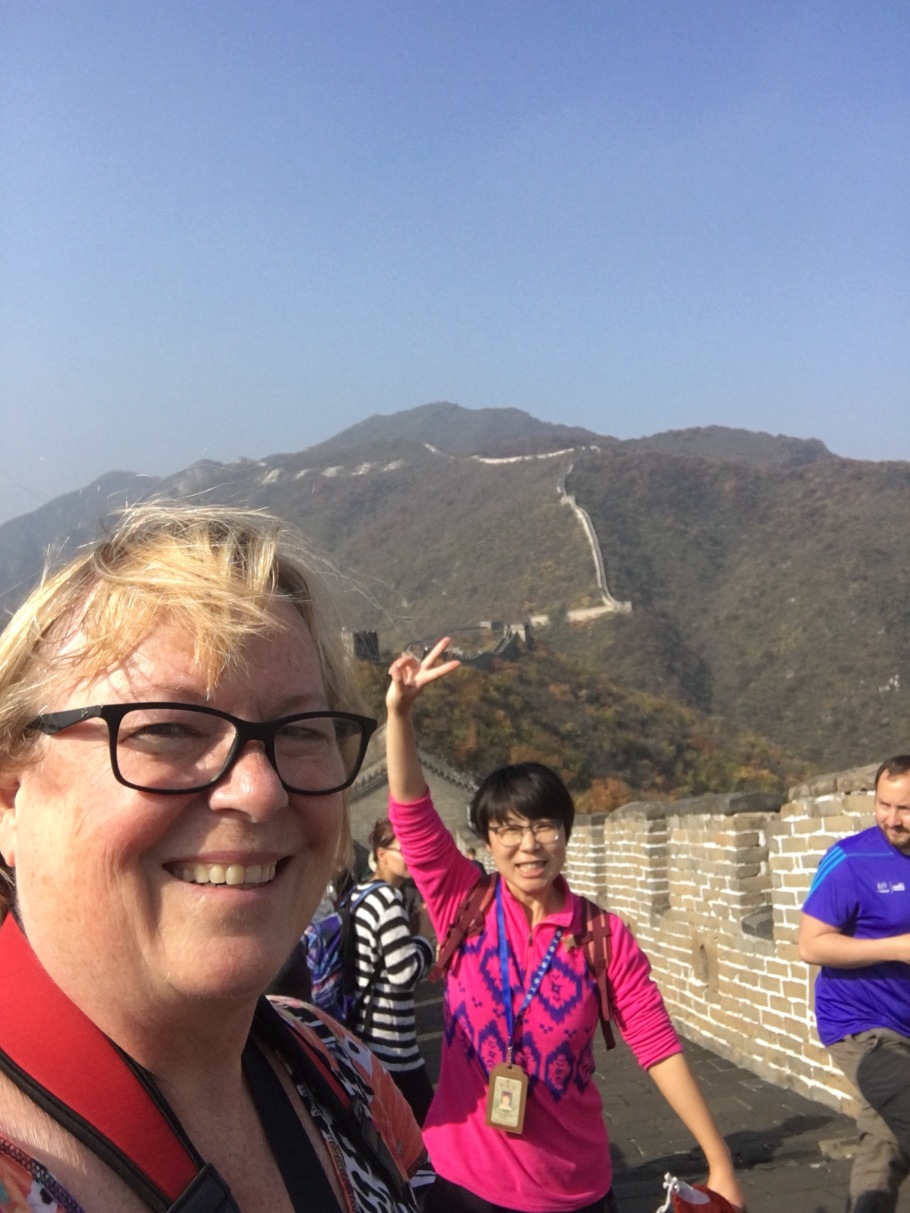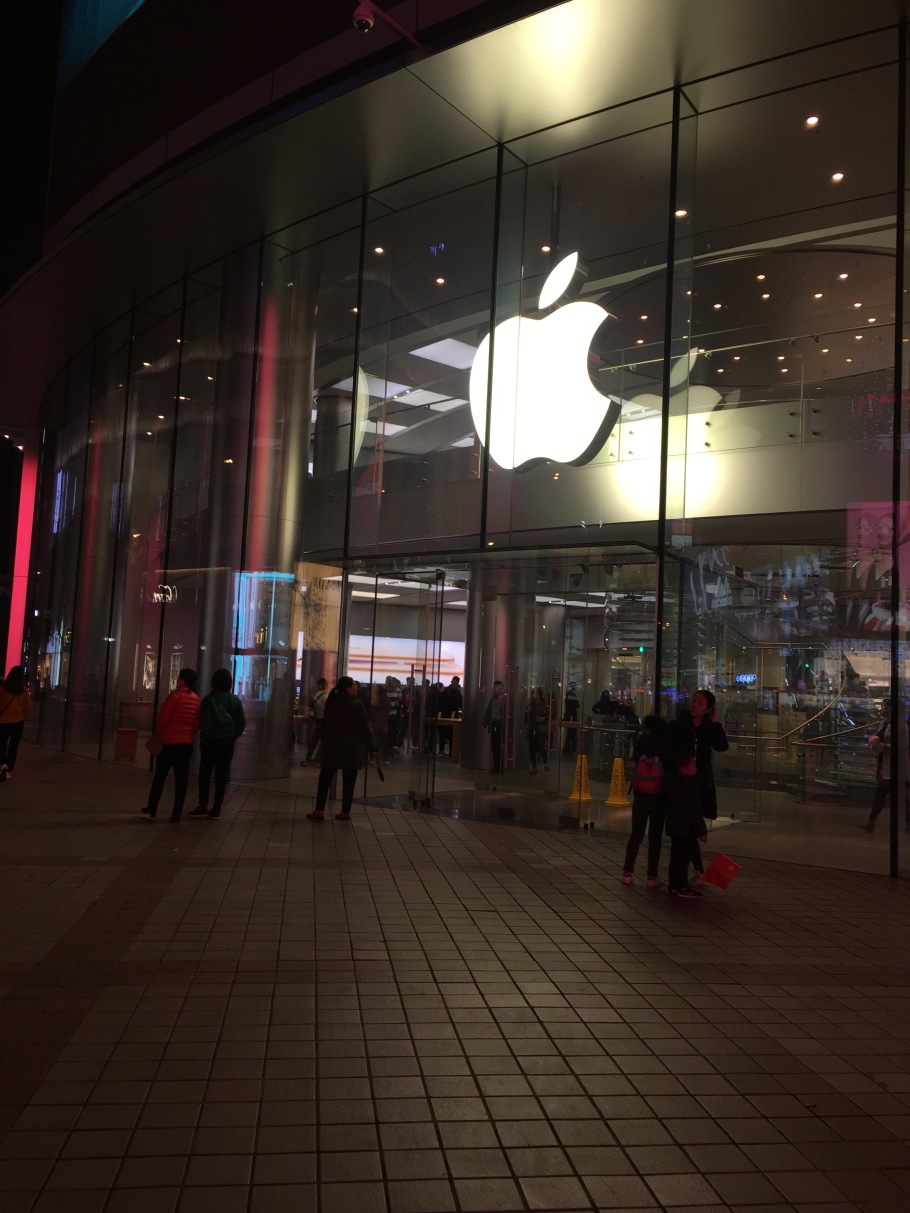The Great Climb to the Great Wall
Day 23, Grand Asia 2017
Tuesday, Oct. 24, 2017 – Tianjin/Beijing, China
Pictures don’t do the Great Wall justice. The reality of actually standing on the centuries-old wall would have taken my breath away, had I had any breath by then. Reaching the wall was the culmination of a shin-burning long walk up a steep road, countless stairways (my Fitbit reported 31 flights, but it’s not always accurate) and a cable car ride. How had I not known that the wall was built on the top of the mountains, not through the accessible valleys?
Once on the wall, I was glad I had persevered. I can’t imagine the effort that went into the construction. We visited the Mutianyu section of the wall, first built in Northern Qi Dynasty (550-557). During the Ming Dynasty (1368-1644) generals fortified the wall here to protect a strategic pass, and it is one of the few sections that are renovated. This section is about 25 feet tall and 12 to 15 feet wide, with 23 watchtowers.
 We arrived at the wall between watchtowers 13 and 14. The wall here was a relatively smooth but steep path. I could see many visitors all along the way in the distance. Our small group of 12 had a busy day so we didn’t linger long enough for an extensive visit. We had plenty of time to explore the immediate area and snap photos, sometimes photobombed by our guide, Li Hui (English name Sonia).
We arrived at the wall between watchtowers 13 and 14. The wall here was a relatively smooth but steep path. I could see many visitors all along the way in the distance. Our small group of 12 had a busy day so we didn’t linger long enough for an extensive visit. We had plenty of time to explore the immediate area and snap photos, sometimes photobombed by our guide, Li Hui (English name Sonia).
Our day started around 8 a.m. with a somewhat laborious Chinese immigration process involving long lines while waiting for scrupulous examination of our Chinese visas. (Most of us sent our passports to an expeditor to get our visas several weeks before the cruise. But I met one woman who failed to get her visa in time and has to stay on the ship for both of our Chinese ports.)
Tianjing is a port city about three hours from Beijing, depending on traffic. We passed flat open areas heavily planted with small trees, interrupted by clusters of a dozen or so skinny high-rise apartment buildings. I never quite understood who lives in them, as there wasn’t much evidence of nearby factories or offices. Apparently many apartments are vacant.
During the drive our guide Sonia filled us in on Chinese history, Beijing customs and details about our two-day tour. She spoke excellent English, so we didn’t have to struggle to understand her. Learning more about Chinese history was good, but we most enjoyed hearing about her childhood in inner Mongolia, her experiences at the university and working for IBM in Beijing, her family, three-year-old daughter and everyday life. (Sonia works for Catherine Lu tours, and I highly recommend her to anyone planning a trip to China.)
We lucked out on the weather – sunny skies. Or at least as sunny and clear as they get in Beijing, where the air quality is notoriously poor. Also working in our favor was the concurrent meeting of the Community Party Congress, during which the city took steps to reduce air pollution. After rain throughout our Japanese stops, we enjoyed the dry weather.
The Mutianyu section of the wall is about 40 miles north of the center of Beijing, on the far side as we approached from the southeast. Some say this section isn’t quite as spectacular as the Badaling section that is slightly closer, but it is less crowded. While the approach is steep, the path on the wall is smooth with even steps. Those who reported on Badaling said the wall had hugely uneven steps there, sometimes with rises of 16 inches or more.
We took advantage of the western toilets near the parking lot before leaving the Great Wall. In typical Chinese toilets you squat over a hole. In tourist areas, signs on the stall doors indicate whether you squat or sit. Almost all of them are BYOTP – bring your own toilet paper. You know it’s a nicer facility when the odor isn’t overwhelming. A good guide earns her tips in selecting the best toilet facilities for westerners.
After the Great Wall we had a late lunch at a nearby restaurant featuring typical Chinese food from local farms. The 13 of us sat at a large round table as servers brought dish after dish, crowding the large lazy susan. My favorite was a green bean dish, but everything was excellent – chicken and pork dishes, slightly spicy noodles, mushrooms, eggplant, rice, broccoli and scallion pancakes (a traditional dish to welcome visitors). All washed down with Yanjing beer.
One reality of touring Beijing is that it takes a long time to get from one site to another. The distances are significant and the traffic always heavy. The Summer Palace was our final stop for the day, about a 90-minute drive from lunch.
Built during the Qing Dynasty (1644-1911), the Summer Palace offered a respite from the heat of the Forbidden City. Sonia led us through, describing how the Empress Dowager Cixi (whom Sonia called the Dragon Lady) sequentially installed three young emperors (the first two died without heirs) so she could maintain power. The movie The Last Emperor followed the life of the third emperor and the end of the Qing Dynasty. We walked among buildings designed for official business and courtyards, but the highlight was watching the sun fall over the beautiful lake.
Some passengers chose tours that returned to the ship at the end of our first day. I was glad we had decided to stay in the city. A few of us ventured out of the Park Plaza Hotel into the high-end shopping area, seemingly anchored by the Apple Store. I walked into a modern six-story shopping mall, but backed out when I saw Michael Kors, Forever Young and other familiar chains. I hadn’t come to Beijing to see the same stores that are in my local mall.


Since we are not on CC now, can you give us the name of your tour agency? Also, do you know anyone who took the bullet train to Beijing and how successful was that? We are in the excursion planning process for the 2018 Grand Asia, and we are getting lost in the details of a 2-day Beijing excursion. If I understand you, you saw the Wall on the first morning and Summer Palace in the afternoon What the schedule on the second day?
Also, what time were you actually able to disembark in Beijing? Most important.
Thanks so much for your help.
Virginia, I think the tour agency was Catherine Lu. I believe it is one of the top rated on Trip Advisor. I did not make the arrangements.
Sorry, but I know nothing about the bullet train into Beijing and don’t recall any fellow cruisers who did Beijing on their own.
Not sure when we disembarked on the first day. We went to the Great Wall, lunch and the Summer Palace. Both stops were quick in order to do both. Our guide gave us the option of being more leisurely and not doing the Palace. On the second day we did Tiananmen Square, the Forbidden Palace and the Temple of Heaven, plus lunch.
I am glad we stayed in Beijing. It was about 2 1/2 hours from the ship to the city.
Jo
Sent from my iPad
>
Thank you, Jo.
hi Jo great memories. I will be returning to China this May for three weeks. we will be visiting Beijing,Shanghai,Hong Kong, Yahtzee River ruise, panda bears. I am looking forward to the trip. cheers
Wow, that trip to China sounds fun, and you should have plenty of time to really see a number of places. I think of a cruise as just a taste to see what I want to “order” more of later. Have a great time.